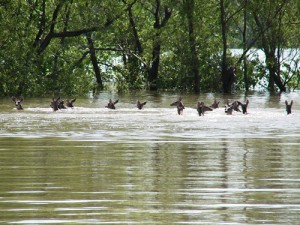 Huge rain and flash flooding here in Virginia this weekend, and it’s moving up the East Coast. Later this spring there will be some flooding in the Midwest and South, as happens every year. How will all this water affect the deer?
Huge rain and flash flooding here in Virginia this weekend, and it’s moving up the East Coast. Later this spring there will be some flooding in the Midwest and South, as happens every year. How will all this water affect the deer?
Biologists say that rising floodwaters of river and creeks won’t kill many if any adult deer, though it will displace animals for days and perhaps weeks. But the deer will eventually filter back into their habitats once the waters recede.
While pregnant does will simply move out of rising water now and for the next few weeks, the primary concern for deer herds in and around flood zones occurs later on in May and June, when the does start dropping fawns.
“But fawn survival in flood plains is typically very high, even during flood years,” says noted whitetail scientist Grant Woods. “To cause any significant problems in a herd, the water levels would have to rise very rapidly and be timed when the peak of fawn births occur, and before the fawns are mobile. This is a relatively narrow window of time. Rivers rarely rise that quickly, and does are excellent mothers.”
One concern is where and how intense flash flooding might wash away and flatten preferred fawning cover. “When does are forced to fawn in fields or woods where there isn’t as much cover left, coyote predation on the fawns can increase,” says Grant.
Researchers at the Mississippi State Deer Lab did a 25-year study in the flood-prone Mississippi Delta and found that winter and spring floods had either no effect on deer, and in some cases a positive effect by enriching the soil in saturated habitats. Flooding during the summer months was a different matter. There was a clear decline in lactation rates and body weights of does. Bucks handle summer flooding better, with no decline in antler size.





